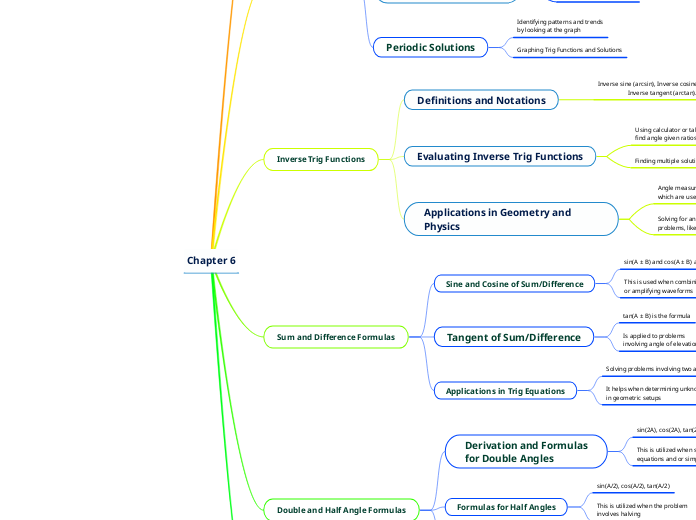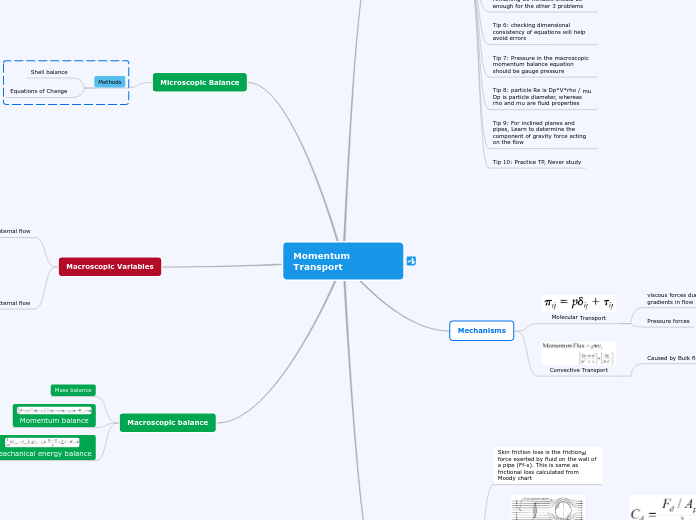Chapter 8
Cross Product
Trig
Trigonometry is needed for calculating the cross product when only the magnitudes and the angle are known
The cross product formula uses the sine of the angle between vectors
The direction of the resulting vector follows the right-hand rule: Point your fingers in the direction of A, curl them towards B, and your thumb points in the direction of A × B
The magnitude of the cross product is |A| * |B| * sin(θ), where θ is the angle between A and B
The cross product is anticommutative: A × B = - (B × A)
For two vectors A = (Ax, Ay, Az) and B = (Bx, By, Bz), the cross product is given by
A × B = (Ay * Bz - Az * By, Az * Bx - Ax * Bz, Ax * By - Ay * Bx)
Unlike the dot product, the cross product results in a vector that is perpendicular to the plane containing the original vectors
The cross product (also known as the vector product) is an operation that combines two vectors to produce a new vector
Dot Product
Properties
A · B is positive if the angle between A and B is acute, negative if it's obtuse
If the dot product is zero (A · B = 0), the vectors are orthogonal (perpendicular)
The dot product is commutative: A · B = B · A
Calculating
A · B = |A| * |B| * cos(θ), where θ is the angle between A and B
A · B = Ax * Bx + Ay * By
It measures the "projection" of one vector onto another, taking into account their magnitudes and the angle between them
The dot product (also known as the scalar product) is an operation that combines two vectors to produce a scalar (a single number)
Vectors
Scalar Multiplication of Vectors
Multiplying a vector A by scalar 'c' results in a new vector with magnitude |c| * |A| and the same direction if 'c' is positive
Scalar multiplication changes the magnitude of a vector but not its direction
Adding and Subtracting Vectors
The result is the vector that connects the starting point of the first vector to the endpoint of the last vector
Vectors can be added geometrically by placing them head to tail
Trigonometry is used to calculate angles and magnitudes in vector calculations
Vectors can be represented using trigonometric notation (magnitude and direction) or Cartesian notation (components)
Vectors are often represented as arrows pointing in a certain direction with a specific length
They are used to represent various physical quantities like displacement, force, and velocity
Vectors are mathematical quantities that have both magnitude and direction
Parametric Equations
Converting to Cartesian Form
Solve one equation for 't' and substitute into the other equation
You can convert parametric equations to Cartesian form by eliminating the parameter 't'
Parametric equations often involve trigonometric functions
Instead of the usual x and y coordinates, you have equations for x and y separately in terms of a parameter, often denoted as 't'
Parametric equations are a way to express the coordinates of a point in terms of one or more parameters
Chapter 7
Polar Equations and Graphs
Limaçons
Shape depends on the values of 'a' and 'b', creating loops and cusps
Polar equations of the form r = a ± b * cos(θ)
Graphing Polar Equations
Identifying symmetrical patterns and repeating loops
Plotting points by calculating r for various θ values
Common Polar Equations
Spiral: r = a * θ or r = a * e^(bθ), resulting in spiraling patterns
Lemniscate: r² = a² * cos(2θ), creating an infinity symbol
Cardioid: r = a + b * cos(θ) or r = a + b * sin(θ), forming heart-like shapes
Circle: r = a, where 'a' is the radius
They allow us to describe complex shapes and patterns not easily represented in Cartesian coordinates
Polar equations express relationships between the distance (r) from the origin and the angle (θ) from the positive x-axis
Polar Coordinates
Problem Solving
Analyzing curves with rotational symmetry
Calculating areas and distances using polar coordinates
Solving problems involving circular or radial symmetry
Limitations
Take care with negative angles and ambiguous notation
Not suitable for every situation, particularly when Cartesian coordinates are more intuitive
Introduction
x = r * cos(θ), y = r * sin(θ)
Polar coordinates (r, θ) represent points using distance from the origin (r) and angle (θ) from the positive x-axis
Cartesian coordinates (x, y) represent points in a plane using horizontal and vertical distances
Area of a Triangle
Using Trigonometry for Area
Helpful when angles and two sides are provided
Area = 0.5 * a * b * sin(C)
If two sides and the angle between them are known, the area can be calculated using trigonometric ratios
Surveying and cartography for determining land areas
Geometry and construction for calculating surface areas
Law of Cosines
Projectile motion and collision analysis
Designing structures, determining forces and tensions in bridges
Calculating distances between points on Earth's surface
Ambiguous Case (SSS)
When given all three sides, multiple triangles might satisfy the given conditions
Occurs when the side lengths form a triangle that can be "folded" to create two different triangles
Formulas
c² = a² + b² - 2ab * cos(C)
b² = a² + c² - 2ac * cos(B)
a² = b² + c² - 2bc * cos(A)
Law of Sines
Astronomy for calculating distances to celestial bodies
Ambiguous Case (SSA)
When given two sides and a non-included angle, there can be two, one, or no possible triangles
Solving
Ambiguous Case: When given two sides and an angle opposite one of them, there might be multiple solutions
Given two sides and a non-included angle, use the Law of Sines to find the missing parts
Law of Sines Intro
Ratio of a side's length to the sine of the opposite angle is constant for all sides and angles
sin(A) / a = sin(B) / b = sin(C) / c
Typically useful when solving triangles that aren't
right triangles
Right Triangle Trig
Real-world Applications
Engineering for designing structures and systems
Navigation, such as determining distances from elevation changes
Special Right Triangles
30-60-90 triangle: One angle is 30 degrees, the other is 60 degrees
45-45-90 triangle: Legs are congruent, angles are 45 degrees each
Trigonometric Ratios in Right Triangles
Tangent Ratio (tanθ) = Opposite / Adjacent
Cosine Ratio (cosθ) = Adjacent / Hypotenuse
Sine Ratio (sinθ) = Opposite / Hypotenuse
Right Triangles
The side opposite the right angle is the hypotenuse, while the other two sides are the legs
One angle is exactly 90 degrees
Chapter 6
Sum to Product and Product to Sum
Product to Sum Formulas
1/2 * [cos(A - B) - cos(A + B)]
sin(A) * sin(B) or cos(A) * cos(B)
Applications
Converting trigonometric equations for easier solving
Calculating areas in polar coordinates
Simplifying integrals and trig expressions
Sum to Product Formulas
2 * sin((A + B) / 2) * cos((A - B) / 2)
sin(A) + sin(B) or cos(A) + cos(B)
Double and Half Angle Formulas
Applications in Trig
Equations and Calculations
Simplifying trig expressions in
calculus problems
Calculating and unknowns in scenarios
with reduced angles
Formulas for Half Angles
This is utilized when the problem
involves halving
sin(A/2), cos(A/2), tan(A/2)
Derivation and Formulas
for Double Angles
This is utilized when solving trig
equations and or simplifying
sin(2A), cos(2A), tan(2A)
Sum and Difference Formulas
Applications in Trig Equations
It helps when determining unknown angles
in geometric setups
Solving problems involving two angles
Tangent of Sum/Difference
Is applied to problems
involving angle of elevation
tan(A ± B) is the formula
Sine and Cosine of Sum/Difference
This is used when combining
or amplifying waveforms
sin(A ± B) and cos(A ± B) are the formulas
Inverse Trig Functions
Applications in Geometry and Physics
Solving for angles in real world
problems, like inclined planes
Angle measures in right triangles
which are used later in the course.
Evaluating Inverse Trig Functions
Finding multiple solutions.
Using calculator or tables to
find angle given ratios
Definitions and Notations
Inverse sine (arcsin), Inverse cosine (arccos),
Inverse tangent (arctan).
Trig Equations
Periodic Solutions
Graphing Trig Functions and Solutions
Identifying patterns and trends
by looking at the graph
Multiple Solutions
and General Solutions
General solutions are also
found using parameter "n"
Trig functions are periodic
and have multiple solutions
Solving Basic Trig Equations
Solving basic trigonometry equations
helps identify periodic solutions
You must isolate the trig function
by itself in order to solve the problem.
Trig Identities
Fundamental Identites
Quotient Identities: tan(θ) = sin(θ)/cos(θ), cot(θ) = cos(θ)/sin(θ)
Reciprocal Identities: csc(θ) = 1/sin(θ), sec(θ) = 1/cos(θ), cot(θ) = 1/tan(θ)
Pythagorean Identity: sin²(θ) + cos²(θ) = 1









